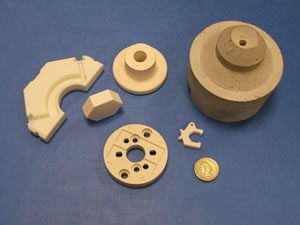Why consider pressed or formed ceramics?
Formed ceramics development has grown out of a long history of the use of ceramic materials, which have been used in industry for an extremely long time. Early man first developed the use of clay based ceramics to facilitate the production of metal tools alongside Chinese production of fine pottery.
Fast forward to today and ceramic materials remain one of the most important materials used world- wide. Without industrial ceramics we would have no metal production, no mass produced fabrics, no petrochemical industry, no electricity supply, and no advanced electronics. A different world to the one we all know.
In most industries today ceramics play a small but vital role in enabling things to be manufactured. In its crudest form a ceramic is basically a natural mineral base mixed with water then bonded together using heat to form the final structure. Today things are more advanced but the basics are still the same.
There are many factors that affect how a pressed or formed ceramics component will function. Our previous article on design thinking for industrial ceramics covers some of the considerations. Here we look at the more fundamental requirements and where we can help to select the correct product for the job at hand.

Raw material selection for pressed or formed ceramics
As with any natural material, quality and impurities are always variable based on where the material is obtained from. The material can be processed to reduce the variables and to blend to requirement.
Grain size
Most pressed or formed ceramics components these days are made using a blend of grain sizes from fines to larger grains. The mix will depend on the forming method to be used and the desired performance required.
Formed ceramics moisture content
When mixed with the binding agent the moisture content of the ceramic mix is important to the method of forming and to the accuracy of the finished component. Pressed ceramics need to be dried before the final firing. During the drying process (And also during the firing) the component will shrink to a degree. This needs to be carefully controlled.
Forming method
The forming method chosen for a specific pressed ceramics components will have a significant influence on performance. For example if we take a standard 95% alumina material formed by different methods, then the real world performance will vary, depending on the forming method selected. Each method has advantages and disadvantages, and need to be matched to the customer requirement.
The ceramic industry today fully understands the variables involved in producing finished parts using different methods and has made considerable strides in the last 100 years to control the material, forming and firing processes to provide stable products.
We at Anderman are ideally suited to finding the right Formed Ceramic to meet our customer needs. With supply partners around the world we have access to a wide variety of materials and forming methods to be able to tailor the product to suit the application.